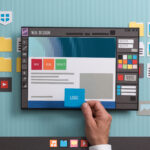6 healthcare design trends to look out for in the coming 5 years

How did the pandemic affect current trends in healthcare industry?
Globally, the Covid-19 pandemic has tested the resilience of our healthcare systems and exposed the gaps in the overall healthcare design, in both developed and emerging countries.
From the stark inability to handle & contain widespread infections to mismanagement of healthcare resources, the pandemic did open a Pandora’s box of unavoidable debacles., This has forced forcing people to face have difficult conversations headfirst.
Dialogues about a proactive & inclusive healthcare design system that makes the best possible use of available tech and other resources paving the way for a more robust healthcare design system.
How can design thinking help the healthcare sector?
The biggest benefit of design thinking in healthcare is that it makes the healthcare sector become more proactive than reactive.
Healthcare is no longer limited to hospitals, clinics, and physical consultations. Today, the healthcare industry consists of the entire phygital (physical +digital) spectrum of offerings, services, & touchpoints. Virtual consultations, healthcare apps, e-medicine, and many more now form the core of what we call as the new age healthcare, one that provides an omnichannel experience to all the patients.
This industry is extremely complicated and evolves at a much faster pace than most industries. From elderly care to mental health awareness to infectious disease containment – all of these problems require deep understanding of rapidly changing patient requirements along with advancements in medical science, making design thinking the key to solving the diverse array of complex problems.
In-depth user research, brainstorming, ideation, prototyping, & other core stages in the process of design thinking are non-negotiable when it comes to designing proactive, resilient, & all-inclusive healthcare solutions.
The present & the future of healthcare systems is deeply intertwined with our ability to implement strong design thinking & principles in creating systems that not only enable swift recovery from the current pandemic, but also successfully avert future global-level outbreaks
The future of healthcare design – Emerging healthcare trends 2023
Healthcare design trend #1 – Ruggedly patient-centric healthcare experience design
Hospitals are significantly burdened attending to severe/urgent/acute cases while also catering long-distance healthcare services for non-acute cases.
With such increasing dependency on healthcare systems, it is imperative that patients become more proactive with their health. This implies, increase in personalized healthcare technology that enables people to track their health along with integrated digital solutions that fill the voids within the current home healthcare delivery.

Healthcare organizations are working on bringing this huge transformation in how healthcare services are delivered to people by extending their own telehealth initiatives and programs. The coming years will be marked by rapid increase in healthcare & hospital chains rolling out their own apps & full spectrum of omnichannel services, along with a variety of self-service digital portals.
Wearables, remote patient monitoring, & similar tech are going to expand in the recent future, opening newer sets of challenges such as designing for accessibility, inclusivity, and features that can work offline, considering there are still billions of population living outside the high-speed internet ecosystem.
Healthcare design trend #2 – AI & Automation for reducing healthcare burden
AI/ML and automation have already proved their worth in making healthcare services efficient, accurate, and proactive. Over time, these technologies will become essential in building highly resilient healthcare solutions.
The current pandemic exposed considerable voids and limitations, in current healthcare industry, in delivering timely care and reducing healthcare costs. During the same period, we saw an unprecedented shift towards virtual healthcare, an action triggered by necessity & high flexibility.

As doctors and the supporting staff are occupied handling the rush of Covid-19 patients, being pushed to their limits owing to short staff/illness/mandated quarantine, the demand for automated solutions that can lower their burden and/or anticipate needs is increasing.
What we need today are efficient, touch-free interfaces that utilize NLP (natural language processing), a segment of AI that enables machines to decode spoken remarks, through seamless connection with a patient’s electronic health record.
Along with this, effective chatbots in healthcare apps and websites can help reduce the bottlenecks to a large extent by automating a significant number of steps related to symptom-checking, appointment booking, etc.
Going one step further, more complex implementations of AI in healthcare design will include sophisticated algorithms that can accurately detect major health conditions such as cardiac diseases and even cancer.
Additionally, tech-driven design solutions in the healthcare sector could also see a larger penetration of AI/ML such as in case of robot-assisted surgery, virtual assistants for pill reminders, & more.
Healthcare design trend #3 – The rise of telehealth & remote care
As per Bain & Company, currently 17% of doctors (in the USA) are using telemedicine and this number is expected to grow to 40% in the coming couple of years.
Wider use of telehealth and remote patient monitoring solutions will enable quality home-based care at reduced costs. Doctors, especially the ones who provide primary care, are focusing on technology that can augment access to healthcare and better management of complex cases such as patients with chronic diseases and other risk factors.
The initial pandemic months (Feb 2020 – April 2020) saw a record 78X increase in the telemedicine usage. During the onslaught of the pandemic, telehealth & remote patient care offered a convenient bridge for millions of people across the globe with easy access to quality treatment.
Telehealth now stands at the cusp of completely reinventing virtual and hybrid virtual/in-person care models, with the aim of improved healthcare access, outcomes, at reduced costs.

Not to mention the consumer & healthcare providers’ attitude has changed a lot towards telehealth offerings. However, certain barriers which tech & design has to overcome are issues of data security to make telehealth design a sustainable solution.
Additionally, the investment in the digital healthcare sector has increased by 3X (compared to the 2017 figures), triggering more innovations across verticals within this industry. Today, telehealth is not a mere extension of urgent virtual healthcare & support but also includes longitudinal virtual care, integration of telehealth with other virtual health solutions, and hybrid virtual/in-person care models.
Healthcare design trend #4 – Data Analytics for large-scale healthcare support
Legacy IT systems are being outperformed by innovative technologies that leverage “big data” to draw insights and thus enable data-driven decision-making.
One of the biggest domains this technology has impacted is the healthcare sector, as more & more data analytics, especially predictive analytics are being implemented to make digital healthcare more authentic, accurate, and personalized.
The global healthcare big data analytics investment is predicted to hit the $ 9.5 billion mark by the year 2023. From large scale vaccination drives to country-level disease containment processes, big data analytics is rapidly becoming an absolute requirement by government bodies as a measure to improve public healthcare quality.
These solutions have the potential to tap ZBs (zettabytes) of healthcare data, opening avenues for improved patient-care along with the complete transformation of the entire healthcare ecosystem.

From improvements across preventive healthcare to resource management to reducing hospital bottlenecks and the development of data-driven healthcare initiatives, big data lies at the core of everything. In fact, big data is making a comprehensive outlook & approach to healthcare like never before, a reality. It can take up feeds from social media, pollution levels, climatic conditions, lifestyle habits, & more to provide a more holistic point-of-view to health.
The different types of medical & healthcare information included within the healthcare big data analytics ecosystem are
- Patient’s clinical history – symptoms, diagnosis, treatment, etc.
- Patient profiles
- Admin data related to logistics
- Supply chain of medicines & medical equipment
- Insurance claims info
- IoT data – health monitors, connected medical devices, wearables etc
- Data pertaining to pharmaceuticals, public healthcare services, etc
- Global healthcare bodies such as the WHO
At the micro-level, data analytics & predictive analytics models unlock better patient care and efficient optimization of resources. At the macro level, healthcare data collected across agencies, geographies, and ethnicities over a large span of time, can help procure an integrated picture of global health conditions for data-driven policymaking.
Healthcare design trend #5 – AR/VR & Mixed Reality in healthcare
AR as a patient-facing engagement tool is gaining momentum. From self-guided rehabilitation programs that treat chronic pain to aesthetic medicine & orthodontia markets, AR/VR modules are being seamlessly integrated into mainstream healthcare practices.

In addition to these, AR/VR technologies in healthcare can be used in the following areas:
- Mothers-to-be in the labor and delivery room for a visual distraction.
- Helping medical students prepare for surgeries during classroom training
- Instead of X-rays, AR/VR can be used to show 3D depictions of areas that need attention and how the corrective procedures will be carried out.
- Physical therapy exercises as a part of remote care
- Management & treatment of mental health disorders such as PTSD, anxiety, depression, etc. for meditations & relaxations in safe, controlled spaces.
- AR maps can help people find medical centers, pharmacies, etc. more easily.
- AR/VR can also enable robot-assisted surgeries
- This can also improve self-diagnosis, especially so in the case of remote patient care, where visiting hospitals could be a challenge
To facilitate these AR/VR solutions in healthcare, an An appropriate high-performance computer infrastructure would be needed to facilitate these AR/VR solutions in healthcare . Since this technology operates in real time, the digital platforms have to be built keeping in mind high speed internet connectivity along with cloud computing.
VR and AR can help doctors better explain to their patients how their operations will be performed or which steps a patient should take for more effective recovery. Though AR/VR is still in its nascent stage in the healthcare sector, its critical role in paving a path for highly structured, personalized, & immersive healthcare experience in the near future cannot be denied.
Healthcare design trend #6 – Cloud computing in healthcare sector
Cloud-based healthcare systems can enhance the patient experience manifold. From easy appointment bookings to automated reminders (for both patients & doctors), along with timely interactions with doctors and upcoming facility information – all of these & more can be done seamlessly through adoption of cloud computing in healthcare.
Reiterating the importance of big data analytics for healthcare modules, cloud computing can ease the burden of managing voluminous structured & unstructured data, enabling running of predictive analytics models that support real time decision making.

Cloud computing can slash down the costs of maintaining on-premise computer networks, IT staff, and related infrastructure & management solutions. Additionally, cloud computing can improve data backup, protection from data loss, medical device integration, and much more.
Another advantage of using cloud computing in the healthcare sector is that it helps in securing patient data and ensuring regulatory compliance.
Designing for healthcare
Designing solutions for healthcare is all about understanding the unaddressed needs & pain points of the patients, along with the doctors & caregivers, and creating an ecosystem of care that fosters better health, both at micro & macro levels.
A patient-first design system with intuitive, personalized, and robust features that aims to seamlessly integrate the entire healthcare ecosystem with the widely pulsating healthcare & support needs of patients across geographies and economic statuses is the need of the hour.

While the pandemic did expose us to a plethora of gnawing issues within the healthcare sector, it also accelerated innovations across different verticals within this industry, and changed the attitude of people towards digital healthcare.
The solution to the existing problems of infection containment, large-scale vaccination drives, and averting future pandemics lies within making the best possible use of the current momentum of digital healthcare disruptions across the globe.
A stronger, more cohesive collaboration between healthcare providers, institutions, policymakers, and designers is needed to best understand what works & what doesn’t for patients from all demographics, setting a course for an improved, proactive, and resilient healthcare design system.


